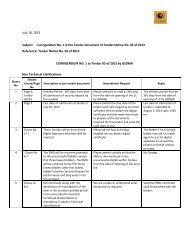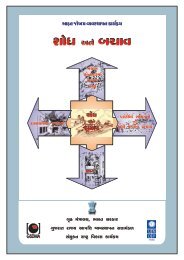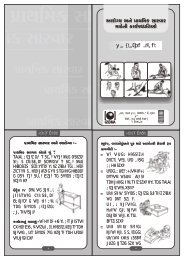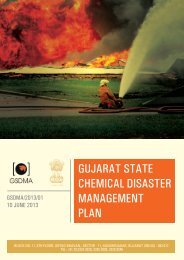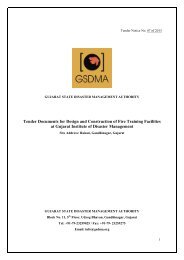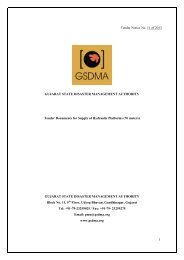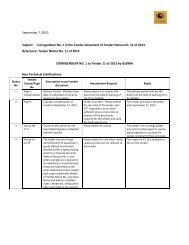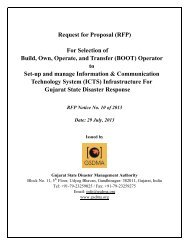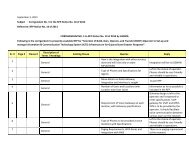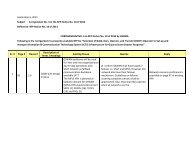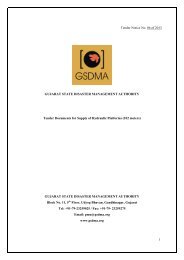Emergency Response Guidebook - Gujarat State Disaster ...
Emergency Response Guidebook - Gujarat State Disaster ...
Emergency Response Guidebook - Gujarat State Disaster ...
You also want an ePaper? Increase the reach of your titles
YUMPU automatically turns print PDFs into web optimized ePapers that Google loves.
INDICATORS OF A POSSIBLE RADIOLOGICAL INCIDENT (continued)Heat-emitting materialGlowing materialSick people/animalsPERSONAL SAFETY CONSIDERATIONSMaterial that is hot or seems to emit heat without any signof an external heat source.Strongly radioactive material may emit or causeradioluminescence.In very improbable scenarios there may be unusualnumbers of sick or dying people or animals. Casualtiesmay occur hours to days or weeks after an incident hasoccurred. The time required before symptoms areobserved is dependent on the radioactive material used,and the dose received. Possible symptoms include skinreddening or vomiting.When approaching a scene that may involve CB agents or radioactive materials, the most criticalconsideration is the safety of oneself and other responders. Protective clothing and respiratoryprotection of appropriate level of safety must be used. In incidents where it is suspected thatCBRN materials have been used as weapons, NIOSH-certified respirators with CBRN protectionare highly recommended. Be aware that the presence and identification of CB agents orradioactive materials may not be verifiable, especially in the case of biological or radiologicalagents. The following actions/measures to be considered are applicable to either a chemical,biological or radiological incident. The guidance is general in nature, not all encompassing, and itsapplicability should be evaluated on a case-by-case basis.Approach and response strategies. Protect yourself and use a safe approach (minimize anyexposure time, maximize the distance between you and the item that is likely to harm you, usecover as protection and wear appropriate personal protective equipment and respiratoryprotection). Identify and estimate the hazard by using indicators as provided above. Isolate thearea and secure the scene; potentially contaminated people should be isolated anddecontaminated as soon as possible. To the extent possible, take measures to limit the spread ofcontamination. In the event of a chemical incident, the fading of chemical odors is not necessarilyan indication of reduced Vapour concentrations. Some chemicals deaden the senses giving thefalse perception that the chemical is no longer present.If there is any indication that an area may be contaminated with radioactive materials, includingthe site of any non-accidental explosion, responder personnel should be equipped with radiationdetection equipment that would alert them if they are entering a radiologically compromisedenvironment, and should have received adequate training in its use. This equipment should bedesigned in such a way that it can also alert the responders when an unacceptable ambient doserate or ambient dose has been reached.Initial actions to consider in a potential CBRN/Hazmat Terrorism Event:• Avoid using cell phones, radios, etc. within 100 meters (300 feet) of a suspect device• NOTIFY your local police by calling 108/100.• Set up Incident command upwind and uphill of the area.• Do NOT touch or move suspicious packages/containers.• Be cautious regarding potential presence of secondary devices (e.g. Improvised ExplosiveDevices, IEDs).• Avoid contamination.• Limit access to only those responsible for rescue of victims or assessment of unknownmaterials or devices.• Evacuate and isolate individuals potentially exposed to dangerous goods/hazardousmaterials.• Isolate contaminated areas and secure the scene for analysis of material.Decontamination measures. <strong>Emergency</strong> responders should follow standard decontaminationprocedures (flush-strip-flush). Mass casualty decontamination should begin as soon as possibleby stripping (all clothing) and flushing (soap and water). If biological agents are involved orsuspected, careful washing and use of a brush are more effective. If chemical agents aresuspected, the most important and effective decontamination will be the one done within thefirst one or two minutes. If possible, further decontamination should be performed using a 0.5%hypochlorite solution (1 part household bleach mixed with 9 parts water). If biological agents aresuspected, a contact time of 10 to 15 minutes should be allowed before rinsing. The solution canbe used on soft tissue wounds, but must not be used in eyes or open wounds of the abdomen,chest, head, or spine. For further information contact the agencies listed in this guidebook.For persons contaminated with radioactive material, remove them to a low radiation area ifnecessary. Remove their clothing and place it in a clearly marked sealed receptacle, such as aplastic bag, for later testing. Use decontamination methods described above, but avoid breakingthe skin, e.g., from shaving, or overly vigorous brushing. External radiological contamination onintact skin surface rarely causes a high enough dose to be a hazard to either the contaminatedperson or the first responders. For this reason, except in very unusual circumstances, an injuredperson who is also radiologically contaminated should be medically stabilized, taking care tominimize the spread of the contamination to the extent possible, before decontaminationmeasures are initiated.Note : The above information was developed in part by the Department of National Defence(Canada), the U.S. Department of the Army, Aberdeen Proving Ground and the FederalBureau of Investigation (FBI).Page 372Page 373



